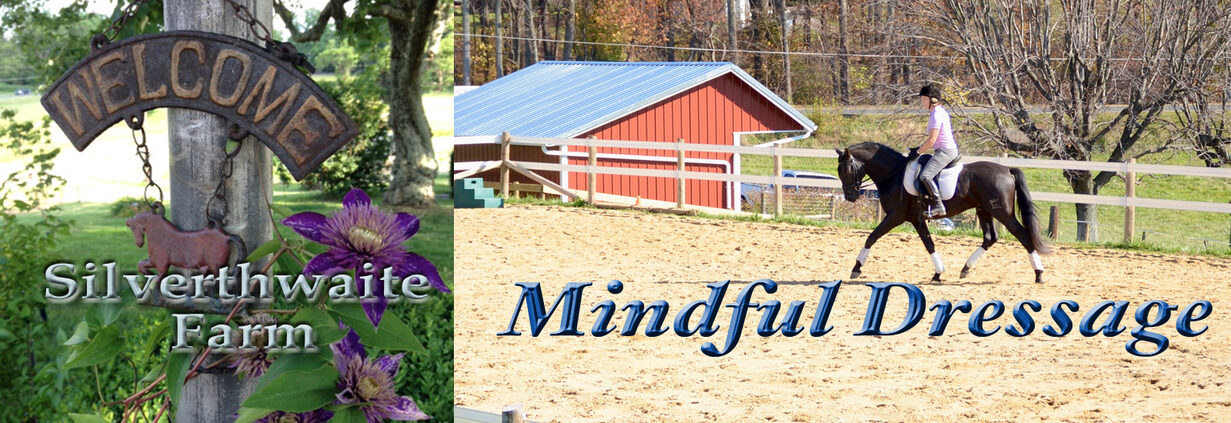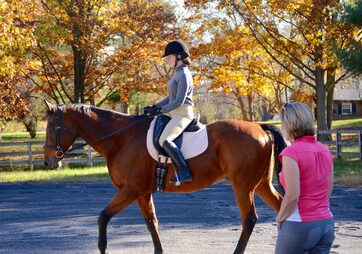As a rider/trainer, it is necessary to constantly re-address the basics of your horse’s training, such as mental relaxation, suppleness, straightness and rhythm, regardless of their level.
But how often do you examine your own skill level and address any weakness?
For example, golf and tennis players take time out of their schedules to work on their swing or back hand to improve their game. They don’t just keep hitting the ball harder.


You may have a training scale with all of the relevant exercises in mind for your horse, but how do you increase your own skill level as a rider? Top riders have a certain number of elements in place, but are often unaware of the exact details, as so much of riding well is based on feelings. They may describe what they do and try putting their feelings into words, but it is difficult to be 100% accurate and often things are lost in translation.
You are an individual (as is your horse), and how you feel in your own body will rarely match what your trainer will feel in theirs (they are a different size, shape, fitness etc). Most horses and riders have an asymmetry, and with correct schooling our horses should become more even, balanced and in better self-carriage. But suppose you are unaware that you always sit heavier on one seat bone and it is closer to the horse’s spine, and one leg is slightly more forward? You decide to ride shoulder in, or even a simple turn or circle …………. your horse can not give you the mirror image of movements on each rein, if your seat and aids are not ‘mirrored’. There are hundreds of little ways a horse can also push a rider into their crooked body pattern. Instead of the rider maintaining good posture and core strength and helping reshape the horse into the correct frame, the horse “cons” the rider to sit in the wrong way. If you develop your own body awareness and work on improving your biomechanics, you will ultimately become a more effective rider.

Developing Feel and Awareness
Accomplished riders have great ‘feel’ and ride on ‘automatic pilot’ (in an unconscious state of mind). But to improve, a rider has to be aware of what their own body is really doing (their individual starting point); understand the changes they need to make; be able to recognize the new correct feelings; and know how to maintain the new body pattern. This is called conscious learning. As your new muscle memory and correct body patterns are established you too will start to ride without thinking as much, through feeling and on automatic pilot!
The Basic A B C’s and Where to Start
It is usually best to start with corrections to the seat and pelvis and then work up or down the body. If the pelvis is not correct the rider will make compensations somewhere else in their body, often by using too much hand. The same principles and corrections apply to all riders from beginners through FEI.
| Here I show a series of photos with my student, Stephanie Bradley-Green riding Izzy, as examples of how biomechanics can impact the rider and horse. |

Here Stephanie is warming up on rather too long a rein in canter, and not asking for Izzy to be connected in any way. Even with the angle of the photo not being perfect, it is still possible to see that Stephanie's lower leg is too far forward and if the horse were "magically" removed from under her she would land on her bum and not correctly on her feet.
Stephanie's thighs are not connected in the right way and she has dropped into the hollow in Izzys back (the man trap). So she is not supporting her own body weight or in correct balance.
Alignment
The rider should have a straight line from shoulder-hip-heel (and elbow- rein-bit); seat bones pointing straight down; and as close to “neutral spine” as possible (giving the stance, strength and stability of a martial artist). When the thigh is rotated inwards and placed at approximately 45 degrees, the rider becomes more balanced, “in-self carriage” and centered over the horse’s center of gravity. If the horse were magically removed, the rider should land on her feet on the arena surface. Not on her face (fork seat with seat bones pointing back) or bum (chair seat with seat bones pointing forward). If you are incorrect in this basic alignment you are hindering the horse from being in balance, and your aids will be less effective.

Adjusting the pelvis and seat-bones.
After changing her pelvis angle and having Stephanie point her seat bones straight down (plugging in), I place my hand on her thigh and ask her to engage the top section of her thigh. This is her weakest thigh. The lack of tone in her thigh, has a 'knock on effect" that allows her lower leg to shoot forward. It also causes instability on the left side of her pelvis and left seat bone (which can then cause other unwanted issues). Putting "thighs on" in the right way enables the rider to support her own body weight.

Addressing the lower leg.
I can now address her lower leg. By adding a resistance with my hands, I can have Stephanie push into the resistance in various ways. The rider will then become aware of the change of tone in various muscles and allow her to identify the various areas that need to be more "engaged" in order to keep the correct alignment. The same approach is done on her right side, although the changes she has to make may be different, due to her asymmetry.
| Bear Out - Establishing core stability | |
|
|
As the horse moves, the rider has to “keep up” with the movement and power of the horse. It is easy for riders to bounce and possibly get left behind or go in front of the movement. Having a strong core and correct seat connection, along with breathing from low down inside your torso, will enable you to “match” your horse’s power. Instructors often misuse the phrase “relaxation”. Riding well is about good muscle tone and not about being relaxed and soggy like a bowl of jelly. When a correction is made on one side of the rider (and hopefully the horse) it is important to notice what may improve, stay the same or go wrong with the other side of the body. Riding well requires constant adjustments to the front/back and side/side plane as well as internal muscle changes to stay balanced and effective. |

Establishing correct core engagement.
To help establish correct core engagement, I again do the hands on approach. Stephanie has to "make a solid wall in her front by pulling her belly button back in line with her collar bone, pubic bone and sternum and then push her guts against it". This is called "bearing out" and it is using similar muscles to giving birth or pushing hard to go to the loo.
I use my hands in several areas of her core. I can feel how strong or weak the rider is in different areas. By using some additional images and exercises the rider can develop the right feel within their own body.
|
Keeping the corrections on a moving horse. Stephanie is doing a good job with her body looking like a "solid box" and a straight line from shoulder-hip-heel.
|

Correct lines from elbow to the bit encourage reach.
Her thighs are "globbed on" in a good "kneel down" way and she looks connected. This encourages Izzy to come up in his back instead of hollowing. Also note the correct line from elbow, through rein to bit, and Izzy reaching to the bit.
 Losing core strength can cause "draw back".
Losing core strength can cause "draw back".
Here Stephanie has lost some of her core strength. There is a "draw back " in her posture and her hands, almost as if she had been punched in the stomach and her seat bones no longer point straight down. Her reins are also a little too long. This can add to the rider "pulling back" in body and hands, instead of engaging their core and "pushing away".
Any time a rider does not have enough core strength they will start to ride with too much hand.

Correcting Asymmetry.
Once the rider is able to maintain better control of their body on the 'front/back plane" the riders 'side to side' asymmetry can be addressed. From behind Stephanie is stacked up in a good way although She is slightly collapsed on the left side of her ribs.

The "knock-on effect".
By having Stephanie change the tone and connection of the top of her left thigh, it has had the 'knock on effect" of correcting the small collapse in her torso. Her right leg has popped off during the correction but possibly due to Izzy moving and shifting his weight. This will not necessarily be the right correction for every rider who collapses to one side
| Understanding your biomechanics is not just about correcting your position and sitting pretty, although that is part of the outcome. It's a means of helping prevent you from being the cause of a problem in your horse and giving you extra skills to make correct changes in your horse's body. The same principles apply whether you are a lower level or FEI rider. Once the corrections become easier to maintain in walk, trot and canter, the rider can move on and add various movements according to their horses needs, making sure while doing this that they are still keeping their body organized in the right way. As movements are added, it will be necessary to go deeper into the layers of the 'riding onion' and find more subtle and effective ways to positively influence the horse, and keep both horse and rider in balance and self- carriage. |

